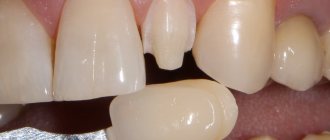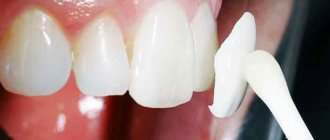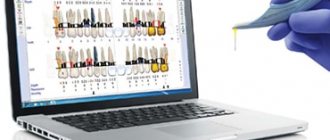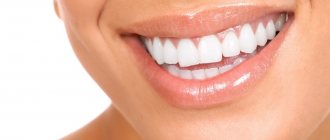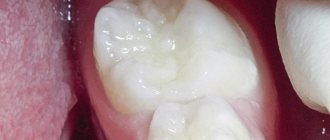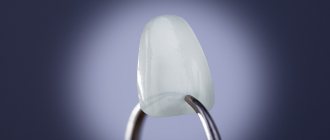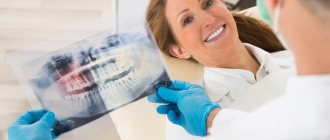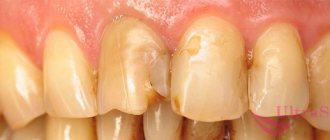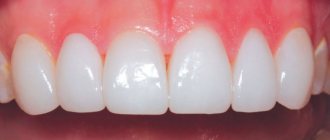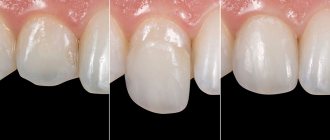1000
A healthy and beautiful smile increases a person’s self-esteem and makes his appearance more attractive.
Very few people can boast of their naturally impeccable teeth; many have to put in a lot of effort to acquire the desired Hollywood smile.
This is why aesthetic dentistry has become very popular recently.
How can digital technology help transform your appearance?
Our clinic actively uses Digital Smile Design technology (“digital smile design” or DSD, read as “digital smile design”) in combination with the principles of Dental Face Lifting (“dental facelift”). Based on the capabilities of digital computer modeling, we restore the ratio of the proportions of the face and teeth according to the “golden ratio” principle using orthopedic and orthodontic structures (for restoring teeth with the help of dentures, as well as correcting the bite, respectively).
We recreate the correct anatomy of the teeth, normalize the chewing load, restore youth to the facial contour and get exactly the smile that suits the patient best.
Every person is unique. Therefore, there are no template solutions. The patient’s personal information is loaded into the Digital Smile Design program - his photographs, computed tomography and intraoral scan data. Based on them, the doctor creates a model of the future smile, taking into account all individual anatomical features. And then the models are transferred to the articulator in order to verify the bite relationships and make adjustments if necessary.
Digitally designed veneers transform your smile and look more natural
All the necessary proportions and measurements are included inside the program. She suggests how best to work out the aesthetics and draws up a step-by-step treatment plan.
Making veneers is a multi-stage and expensive procedure; the cost of an error is quite high. Therefore, it is useful for all participants in the process - the patient, the orthopedic surgeon and the dental laboratory specialists - to have the same information, which cannot be interpreted in their own way. It is this consistency that careful planning of the treatment process can achieve.
The DSD program transmits clear data backed up by 3D images to the laboratory. Everything is taken into account: the shape, shade, height and width of future restorations, their exact positioning and relationship with the gum. Distances are adjusted to fractions of a millimeter, and the color of future veneers is selected on a scale taking into account the color of the patient’s eyes and skin.
This means that the risks of the human factor are eliminated. There will be no errors in color perception or distortions in shape. The laboratory, the orthopedic dentist and, of course, the patient will not differ in their expectations of the result.
Ceramic veneers
natural look requires turning Price: from 25,000 rub. Price: from 25,000 rub.
Zirconium veneers
stronger and thinner turning is required Price: from RUB 25,000. Price: from 25,000 rub.
Ceramic composite
light and durable turning is not always required Price: from 15,000 rubles. Price: from 15,000 rub.
Lumineers
the thinnest veneers do not require turning Price: from 65,000 rubles. Price: from 65,000 rub.
We create beautiful smiles! Veneers and lumineers are non-staining and protect teeth. 3D modeling is included in the price!
Free consultation
Photo and video materials
During the examination and consultation, the doctor asks the patient in detail what result he wants to get. In some cases, the patient simply needs to model the front teeth when smiling, taking into account the shape, size, and shade. In other cases, it is necessary to restore chewing functions - insert missing teeth, correct the bite.
An important tool in DSD dentistry is photography and video recording of the patient’s face from various angles, as well as the oral cavity (dentition). They are performed using high-quality equipment, which allows obtaining materials in high resolution.
Additionally, the doctor takes impressions of the jaws. They are scanned, and the resulting images are sent to the dentist’s work computer. Advanced clinics have the latest equipment that allows you to do without impressions at all - the doctor scans the oral cavity with a compact camera, immediately obtaining a digital image.
If the doctor has to work on functional problems (for example, installing crowns or bridges on implants), X-rays and computed tomography are included in the diagnosis. If it is necessary to correct the amplitude of movement of the lower jaw, an articulator is used. Using these materials, the doctor receives a complete understanding of the structure of the jaw bone, the location of nerves and blood vessels, and the functioning of the joint.
Signs of a perfect smile
White teeth and healthy gums are not all that define beauty. Sometimes, when looking at a smiling person, we feel dissonance, but we cannot formulate what exactly confuses us. In fact, our brain automatically evaluates the proportions and shade of teeth in combination with the shape of the lips, the height of the face and the color of the skin, and finds inconsistencies.
People intuitively follow the natural law of harmony - the so-called “golden ratio” formula. Everything that obeys this principle looks right, beautiful and young in our eyes.
The doctor’s task is to restore the smile so that all parameters correspond to the canons of natural harmony. Then not only the teeth, but also the person’s appearance will change for the better.
The “golden proportion” is found everywhere - from the structure of flowers to the biorhythms of the human body. And, of course, this law is used in art, exact sciences and aesthetic medicine.
Based on the principle of the “golden ratio,” aesthetic restoration specialists have derived the parameters of a harmonious smile:
- The type of face and the shape of the teeth should be combined. Teeth of different shapes and heights are in harmony with oval, conical or square face types,
- imaginary horizontal facial lines passing under the eyes, under the upper and lower lips should be parallel,
- the level of the visible gum margin should not be too high; ideally, the upper lip should completely cover the gum,
- We take the slight protrusion of the upper incisors from under the lip as a sign of youth when the mouth is slightly open,
- shades of teeth and skin should be combined. Not everyone is suitable for snow-white teeth without an admixture of other natural shades,
- the line of the lower lip and the arc of the incisal edge of the upper teeth should run parallel when smiling,
- the conditional center of the smile should coincide with the vertical line that divides the face in half.
Aesthetic dentistry
The aesthetic direction in dentistry deals with restoring the appearance of teeth. Specialists in this field are engaged in correcting their natural color, shape and position in the row.
In our lives we encounter various problems that affect the state of the elements of the jaw rows:
- Bite distortion;
- Displacement of teeth in a row;
- Loss of one or several teeth;
- Darkening of the enamel;
- Chips and cracks.
Such defects reduce a person’s self-esteem and create difficulties in communicating with other people. Specialists come to the rescue to correct problems and create a beautiful smile.
There are certain parameters that aesthetic dentists use when correcting defects:
- Parallel to the eye line . An ideal smile should follow a conventional line between the pupils;
- Symmetry. It lies in the coincidence of the line between the front incisors and the line between the eyes;
- Outline of a smile . An ideal smile is one in which the lower edge of the upper teeth coincides with the contour of the lower lip. With age, this parameter is distorted for various reasons;
- Gum uniformity . The gum contour should be the same on symmetrical teeth;
- Smile size . The most ideal option is considered to be a smile when 10 teeth are exposed, the appearance of which should be ideal;
- Teeth sizes. An important criterion is the proportions of the teeth. This is especially true for the front incisors. Their height should be related to the width in a ratio of 1:0.75;
- Contour of cutting edges . It should be the same on symmetrical teeth.
After assessing the initial condition of the teeth according to these criteria, treatment directions are determined and a correction plan is drawn up.
Let us consider together the features of preparing abutment teeth for bridges.
Visit here to learn more about the use of Cad Cam technology in dentistry.
At this address https://www.vash-dentist.ru/protezirovanie/nesemnyie-p/koronki-np/vosstanovlenieennoy-zuba.html we will tell you in which cases it is cost-effective to restore the crown of a tooth.
Advantages of computer modeling when designing veneers
- Visibility. Even before the start of any interventions and grinding of teeth, the patient can assess what his smile will look like after veneering.
- Direct participation . The patient sees all smile changes on a tablet or laptop screen. He can make adjustments immediately and be confident that the doctor understands his wishes for appearance and aesthetics.
- Predicted result. Computer technologies and robotics make it possible to make veneers exactly as the patient saw them at the approval stage in the program and when trying on the model. Disappointments are excluded.
- Well-established communication. Digital Smile Design facilitates communication between the orthopedic surgeon and the dental technician, as both rely on the same clear data.
- Speed. Thanks to digital technologies, robotic installation, such as CAD/CAM and 3D printing, you can try on and evaluate your future smile in 2-3 days.
- Process automation. Depending on the software, the finished smile model is uploaded to robotic dental systems. Veneers can be created using high-precision milling equipment.
- Comfort and simplicity. For modeling, you only need photographs and a cast; there is no need to undergo additional and complex diagnostic procedures.
- Aesthetics. The DSD programs are based on the principles of the “golden ratio”, so that any initial situation can be brought to the ideal. At the same time, the functional features of the dental system are taken into account so that beauty does not diverge from health.
We create smiles by working with our souls! Your new teeth will not only be beautiful, but also as comfortable as possible. Free consultation and 3D diagnostics!
Sign up online
Main directions
Aesthetic restoration is carried out by different specialists depending on the identified dental defects and the necessary procedures to correct them.
Each doctor is responsible for a specific area in aesthetic dentistry. In some cases, it is necessary to involve several specialists at once to create a beautiful smile.
Which doctors are involved in the process:
- The hygienist performs procedures to professionally clean teeth from plaque and deposits. Its functions also include carrying out preventive treatment;
- The therapist performs procedures for the treatment of caries, depulpation of canals and filling of teeth, treatment of inflammatory pathologies;
- An orthodontist deals with correcting the bite and aligning the position of the teeth in a row;
- An orthopedist performs replenishment of the jaw row in places of lost teeth and correction of serious jaw defects with the help of dentures and implants;
- The surgeon removes teeth, as well as performs necessary operations on the gums and bones to restore an aesthetic appearance;
- A gnathologist deals with issues related to the structure of the jaws. He is called in for consultation when serious disorders occur in the temporomandibular structure.
Where else is digital smile design used?
Smile planning using digital technology is suitable for everyone who wants to have a harmonious face that is as close as possible to the canons of beauty. There are no contraindications or age restrictions. Therefore, the technology can be used wherever an accurate plan and predictable aesthetic effect of treatment is needed: implantation and prosthetics, the creation of various orthopedic structures, surgical gum surgery and even orthodontic treatment.
In what cases will computer planning procedures help?
- slight disproportion and asymmetry of the face,
- abrasion of enamel and decrease in bite height,
- violations of aesthetics - chips, dark spots, uneven teeth,
- absence of one, part or all teeth,
- age-related changes, wrinkles in the lip area, deepening of nasolabial folds,
- loss of facial muscle tone, drooping soft tissue in the lower third of the face,
- sinking of the cheeks and corners of the lips,
- desire to change the shape and color of teeth.
Digital modeling greatly improves mutual understanding between the prosthodontist, dental technician and patient. As a result, the patient gets exactly the smile he dreamed of.
How a restoration is made
When the model is finally approved, the laboratory begins to manufacture the restoration itself - prosthesis, veneer, crown. For this purpose, automatic CAD/CAM equipment is used, which produces orthopedic structures exactly according to the digital 3D model. Then the patient is invited to the installation and the dentition is corrected directly in the oral cavity. As a result, a person in reality receives the same smile that he had previously seen on the screen and tried on in the form of a silicone overlay.
Rules for caring for a new smile
Despite the fact that computer modeling allows you to create comfortable, beautiful and durable dentures, this does not mean that new teeth do not need to be cared for. On the contrary, proper care will only extend the life of the restoration and preserve its integrity and aesthetics. However, there is nothing difficult about care. Restorations need to be cleaned 2-3 times a day with a brush and paste (only without abrasive particles); you should not bite nuts and candies, chew chewing gum or toffee. And if veneers are installed, then you should not bite off food with your front teeth, especially hard food (carrots, apples, etc.).
For which restoration method is DSD suitable?
Dental prosthetics is carried out using two methods – direct and indirect. But digital smile design is used only in one case, read about it further.
Direct method - the prosthesis is created in the patient’s mouth
The direct method most often involves applying a liquid filling directly to the patient's teeth while the patient is in the dental chair. This is how they restore small chips, cracks, and darkening on the front teeth, and restore chipped enamel of the lateral teeth. Before the filling hardens, the dentist can give the patient a mirror to evaluate the result and tell him whether he is satisfied or not. There is no need for computer modeling here because all the work is done by hand (not in a laboratory).
Indirect method - the prosthesis is created in the laboratory
Dentures created in a dental laboratory are of much higher quality than those produced by the direct method. For the indirect manufacturing method, in addition to the skills of specialists, equipment is required - various forms for real models, firing and baking ovens, milling machines, presses and modern high-quality materials (ceramics, glass ceramics, zirconium dioxide).
Here, the use of 3D modeling of a future smile helps the dental technician better navigate the work being performed, because DSD data is combined with special programs that model the prosthesis itself and control its production. Of course, not all clinics use the original Digital Smile Design program (because they don’t want to purchase it from the developers), and digital modeling, in principle, works the old fashioned way manually. But as practice shows, it is this concept that helps create the most beautiful, comfortable and durable designs.
Benefits of Digital Smile Design
DSD technology benefits both the doctor and the patient. The dentist-therapist, using graphic programs and photographs, develops a plan for restoration work, predicting with high accuracy the optimal appearance of future teeth.
The owner of the future “Hollywood smile” can see its final version before any manipulations begin. The patient actively participates in creating his own smile and can correct it. His opinion is taken into account when choosing the color, shape, and size of teeth. This is very important for the doctor, and especially for the patient, because... the latter cannot imagine exactly what teeth will be obtained in the end; the desired result may not always coincide with the final one.
In addition, the patient is given a unique opportunity to try on a model of teeth before grinding and other dental procedures. Restorative treatment begins only after the preliminary appearance of the smile has been discussed and approved.
The method of computer smile design allows the dentist to closely interact with his patient, using the example of a digital image of teeth to discuss options for aesthetic restoration and translate the desired result into reality.
Aesthetic digital smile modeling: analogue and digital virtual planning
Valerio Bini, doctor
Over the past twenty years, the use of computers in dentistry has radically changed the clinical approach, especially at the analysis stage, creating a real information microcosm and turning the dentist into an information systems operator. Digitization of photographs, which makes it possible to instantly process the image, now accompanies the diagnosis of every clinical case concerning aesthetics.
Using a variety of static positions, virtual planning can be carried out and expressed technologically thanks to the achievements of modern dentistry.
Smile designer: a new method in communication
The dentist is increasingly faced with the system of interdisciplinary treatment plan “Face and Smile”, in which the interdisciplinary examination gives the doctor involved in the aesthetic component a very important, if not the main place. The harmonious combination of teeth, periodontal tissue, face and smile creates excellent aesthetics. It is necessary to have artistic ability and various know-how for complex consideration, balanced design and combination of dental elements in the context of “Face”. Today, beauty and aesthetics are increasingly associated with size, proportion, symmetry - constants known to ancient civilizations and forming their basis. Today they are inseparable from modern technologies, which have radically changed with the advent of the digital era.
Modern scientific knowledge puts at the disposal of professionals various therapeutic options: collaboration between specialists from different fields (orthodontist, implantologist, periodontist, dental technician, oral surgeon, plastic surgeon and aesthetic medicine doctor) and examination by these specialists allows the best treatment plan to be drawn up ( Fig. 1).
Rice. 1. Aesthetic team and interdisciplinary examination
In addition, the doctor can work with images taken elsewhere and obtained via video conference via Skype. This opportunity turns the esthetic dentist into the conductor of an orchestra and the main player in the process. Today, with the advent of digital dentistry, it is difficult for a doctor to work while maintaining high quality of work and ergonomics if he does not have an accurate protocol that can predict the result (Virtual Planning). The use of 2D and 3D software with digital image editing and morphing (Digital Image Editing) makes it possible to process data and individual parameters according to the specific requirements of Smile Makeover - smile formation.
Modern digital technologies, combined with the experience and aesthetic sense of the dentist, become the key to success in smile modeling, ensuring predictability of both aesthetic and therapeutic results for the patient.
The combination of concepts such as aesthetic dentistry, interdisciplinary examination, digital dentistry and predictability gives rise to a new phenomenon in the profession - the “smile designer”, the main advantage of which is the possibility of communication between the patient, the main character in aesthetic dentistry, and a team of estheticians, virtual reality specialists. planning. For quite some time now I have been improving the ADSD system - “aesthetic digital smile modeling”, using various software. ADSD can and should serve as a purely auxiliary method of diagnosis and prognosis, the goal of which is the health and well-being of the patient. In addition, since ADSD is a way to simulate an aesthetic treatment plan, it is advisable to obtain the patient's prior consent for the use of this technique, which only when accompanied by real clinical examples, such as a mock-up, will become clear to the patient. It is important to remember that dentistry requires that the dentist observe three basic principles of the profession: caution, diligence, and experience.
ADSD: methodology and protocol for use
ADSD, Aesthetic Digital Smile Design (aesthetic digital smile design), is, first of all, a way to improve communication with the patient, since it is with the help of processed images that you can see before and after photos on a digital monitor, predict the results of treatment and discuss them with the patient. Another important point is the innovative method of aesthetic and clinical planning in aesthetic dentistry, prosthetic dentistry, which is of great importance for analysis and design in the dental laboratory. This technique can also be used for diagnosis and planning in plastic and maxillofacial surgery. First of all, the protocol involves obtaining patient images through digital photographs and full frame video. Video is especially important, since with its help you can see the dynamic phases of a smile associated with physiological characteristics (facial expressions, phonetics, relationship of dentition and lips). Incorporating this important information into the patient's digital aesthetic record complements the clinical history as it is an integral part of an objective intraoral and extraoral examination and aesthetic analysis. Therefore, we can define this technique as the third part of the analytical processing (Fig. 2) of the aesthetic composition of the smile, the morphological components of the face and smile, including the reference points on which the measurement scale will be based (Fig. 3 a - c). The next stage of digital data processing is Virtual Planning using Digital Image Editing (Fig. 4 a - c), then digital and analog diagnostic wax-up, mock-up, temporary prosthesis, final restoration (Fig. 4d - f).
Rice. 2. ADSD, macro-aesthetic, mini-aesthetic, micro-aesthetic analysis
Rice. 3a. ADSD, Scheduling and Virtual Planning
Rice. 3b. ADSD, Scheduling and Virtual Planning
Rice. 3c. ADSD, Scheduling and Virtual Planning
Rice. 4a. ADSD and its application in a clinical case
Rice. 4b. ADSD and its application in a clinical case
Rice. 4c. ADSD and its application in a clinical case
Rice. 4g. Prosthesis model
Rice. 4d. Virtual wax-up
Rice. 4e. Aesthetic and biological integration of the prosthesis
The digital technique, closely related to image editing, is very reliable, especially when working with clinical cases where functional editing and morphological changes are required. This method is much easier for the dental laboratory to understand than oral explanations. Interaction with other digital systems is also very important, as this makes it possible to use ADSD for digital simulation of an orthodontic situation, digitization of impressions, CAD/CAM method, etc.
Thus, the technique becomes multimedia.
Receive and import digital images
Photographs of the patient should be taken with a good digital SLR camera (possibly a semi-professional one), most importantly in good lighting. Today there are many opportunities to take courses in dental photography, and there are many manuals on this extremely interesting topic. It must be remembered that at the analysis stage, photography is a diagnostic clinical and aesthetic element, which will then become part of the patient’s clinical baggage, different specialists will work with it as part of an interdisciplinary examination. Therefore, the dentist must take photographs of the patient's head in the same position to be used in a smile modeling program. The most reliable position for photographing the patient’s head is the so-called aesthetic plane (Fig. 5), that is, the ratio of the perpendicular (frontal) plane to the plane in the center of the angle formed by the Frankfurt horizontal and the Camper line. The same position should be projected vertically at 45° and 90°, because profile photographs are also extremely important, since they make it possible to analyze the face and teeth from an aesthetic point of view: to record the class of occlusion, the position of the lips, aesthetic angles - all points important for orthodontist, maxillofacial surgeon and plastic surgeon.
Rice. 5. Photography and the aesthetic plane
Analog Face Transfer Support - FATS
The ADSD technique involves transferring the actual dimensions of the photographed object with their configuration in accordance with the pixel system that is used in digital photography. In order to do this, you can use measuring instruments such as a square and a ruler, if possible metal (they are easy to wash and sterilize), or their equivalents. When working with facial analog transfer support (FATS) (Fig. 6a), I use a measuring device that includes a regular ruler with millimeter and centimeter markings. The patient can carry it with him as easily as, for example, glasses.
Figure 6a. Analog face transfer support: analog measurements and digital calibration
This instrument can be made by any dentist or dental technician, subject to some special requirements. The ruler should be light, but clearly visible on the patient's face; the eyes must be visible so that it is possible to determine the position of the pupils; The area around the eyes should also be exposed, including the most clinically and aesthetically interesting reference points. Another important point is the nose pad, which should be comfortable enough to allow us to move the analog dial back and forth freely. When assessing the facial profile, it can be noted that the position of the upper incisors may be slightly shifted in relation to the aesthetic plane. Therefore, in order to accurately take analog measurements, you need to install the nose stop at a point as perpendicular to the vestibular surface of the upper incisors as possible, so that it practically continues this vertical plane. In addition, since prototypes (mock-ups, PMMA prototypes, etc.) still need to be shot, it is advisable to use clamps similar to the craniostat stops installed in the headrest of the dental unit chair. As for even more accurate measurements of individual elements of the dentition and gingival parameters, you can use digital calibers by setting their edge on the cervical line and incisal edge (element length) or on the mesial and distal edges relative to the equator of the tooth (tooth width) (Fig. 6b ). Some digital image editors have an analytical system that allows you to convert the size of a digital photo from pixels to millimeters (analog photo), insert all the object data into the photo and the dimensions obtained using FATS (Face Analogue Transfer Support) (Fig. 6c). One of the most important points is to indicate and store the unit of measurement on the photo for the software conversion system so that the correct data is indicated in the clinical situation. If the dimensions have been previously transferred to an analogue/digital scale, excellent indications of reference points can be obtained. For example, the location of the maxillary central incisors may indicate the distance between the incisal or cervical edge and the point between the base of the nose and the upper lip or the interpupillary line. The dimensions transferred in this way will be especially useful when the dentist interacts with the dental technician, because it is thanks to him that the most important results of this technique are achieved. It must be borne in mind that patients are rarely interested in the dimensions in millimeters in a digital photograph and the design of the contours of the teeth - at the first stage, more visual examples are much more important to them. The dimensions of 3D wax-ups and mock-ups, which are tried directly in the patient's mouth, give the patient a much better idea.
Figure 6b. Analog face transfer support: analog measurements and digital calibration
Rice. 6th century ADSD, transfer of analog dimensions to a computer and measuring grid
Editing Digital Images
There are many ways to digitally process images, depending on the requirements for smile modeling: you can use different programs that are easy to find on the Internet - it all depends on aesthetic experience and on the practice of working with digital images. Some of these image processing and photo editing programs are free, others are paid, some are for beginners and some are for professionals. In the simplest programs it is quite easy to simulate a smile with a schematic construction of the contour of the teeth. Aesthetic digital smile modeling involves DDD (digital dental modeling), which, as I already said, is quite simple - you just need to outline the contours of the elements, choosing the most suitable shape for the new smile (Fig. 7).
Rice. 7. Digital Dental Design: Contours
For this technique, it is necessary to make another model in a dental laboratory, which will then be checked by the dentist and possibly used as a prototype.
Only at this stage, having photographed the patient, can we begin to more accurately model the smile. The ADSD technique provides for such aspects of processing as transfer, adaptation, processing of the shape and type of dentition, taking into account the shape in the photographs. To accomplish these important tasks, you need to create a file cabinet that we will call a DDPD (Dental Photograph Database). This may include: A catalog of tooth shapes is perhaps the most user-friendly database. It can include 5 types of teeth according to anatomical shape and color, and can be easily changed depending on the quality of lighting in the photographs provided by the operator. The tooth shapes contained in this catalog must match the actual shape, for example: triangular, oval, rectangular, square, trapezoidal (Fig. 8).
Rice. 8. Personal database: incisal edge
Catalogs of dentition/smiles that can be called aesthetically ideal: there are some catalogs where the elements are already formed in accordance with the morphology of the incisal edge (flat, square, rounded). Catalogs of teeth for removable dentures - they can be found on the Internet on the websites of manufacturers such as Ivoclar, Kulzer, Vitapan, Candulor, etc. Database of own clinical cases - prosthetics, aesthetic treatment, all previous virtual wax-ups, mock-ups and treated teeth of patients who agree to use their photographs for noble purposes.
Catalog of smiles - models, men and women, who may be useful; you can choose the teeth you like from models, who, as a rule, are photographed by professional photographers in fashion style, and “try on” them. Simply download from paid websites such as 123rf.com, Fotolia.com, Shutterstock.com, Fotosearch.com, etc. Another factor in the smile modeling technique is digital deformation/distortion (DDID), which allows modification of the morphology elements of the dentition. This feature is very useful when creating a DDPD database. It is important to use not only vectors of length and width (Fig. 10 a - c), but also vectors of all directions, both external contours and tooth surfaces.
Rice. 10a. Distortion of dental elements in one direction
Rice. 10b. Distortion of dental elements in one direction
Rice. 10th century Distortion of dental elements in one direction
This treatment is often extremely important for highlights on tooth surfaces with micro- and macro-texture, transfer lines, and interproximal spaces. It is also effective in analyzing contact points and interincisal angles, with the morphological characteristics of the incisal edge and the external contour as a whole, which tell us about the age, gender and personality characteristics of the patient (morphopsychology). DDID is the most important part of the entire ADSD technique because you cannot “print” a standard smile on the patient's mouth. This smile can be composed of ideal elements, but you need to use artistic flair and dental know-how to be able to change them. It is necessary to model, sculpt, deform, increase, decrease or remove elements that do not harmonize with the rest (Fig. 9 a - f).
Rice. 9a. ADSD, digital image distortion
Rice. 9b. ADSD, digital image distortion
Rice. 9th century ADSD, digital image distortion
Rice. 9d. ADSD, digital image distortion
Rice. 9y. ADSD, digital image distortion
Rice. 9e. ADSD, digital image distortion
In many clinical cases, it is advisable to use DDCT (digital calibrated dental transposition), that is, the transposition of elements of the dentition necessary for aesthetic modeling and orthodontic movements that need to be analyzed for further aesthetic treatment, as well as orthopedic or prosthetic with the installation of implants. The transfer of elements to the desired position must be precise, it is necessary to preserve the anatomical dimensions, then it is possible to more accurately plan the future structure not only from an aesthetic, but also from a functional point of view. Quite often in orthodontic cases, mesialization/distalization is required for implant placement, so coordination with the implantologist, orthopedist and orthodontist via x-rays (Dicom, Tac3D) will be required. Only after planning the final position of the dentition elements can the smile designer proceed with aesthetic improvements, modeling them using DDID (digital deformation/distortion). In practice, the doctor and dental technician can use their professional experience using a mouse and conventional modeling tools. The same method is suitable for orthodontic simulation, processing data obtained using programs such as ClinCheck from Invisalign (Align Tech). They can be used in virtual modeling. Processing in 3D changes in the position of elements gives us the opportunity to build an ideal dentition on a millimeter grid with the overlay of before and after options, allowing us to perform virtual planning of aesthetic and orthopedic treatment together with orthodontic treatment.
Conclusion
Today, aesthetic dentistry has new ways of developing a treatment plan: Digital Dentistry technology and software for digital processing of clinical images, which are gradually becoming an integral part of the dental profession. ADSD - Aesthetic Digital Smile Design - is a simple and cost-effective way to demonstrate to the patient the expected treatment result, aesthetic and functional improvements using appropriate prototypes already during the second visit, and then transfer it to the entire Face Aesthetic Medical Team ) information necessary for the work of the interdisciplinary team. Thus, a new figure has appeared in dentistry - the smile designer, its aesthetic architect.
The list of references is in the editorial office
